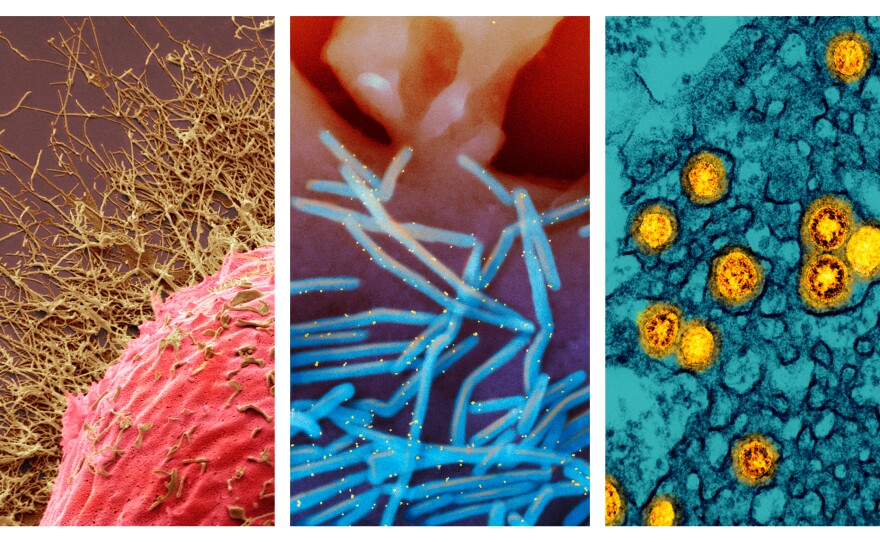For each of the last two years, Thanksgiving helped usher in some very unwelcome guests: Devastating waves of COVID-19.
No one thinks this year will be anything like the last two dark pandemic winters, at least when it comes to COVID-19. But the country is now dealing with a different kind of threat — an unpredictable confluence of old and new respiratory pathogens.
"We're facing an onslaught of three viruses — COVID, RSV and influenza. All simultaneously," says Dr. William Schaffner, an infectious disease specialist at Vanderbilt University. "We're calling this a tripledemic."
Flu and RSV are back, big time
The respiratory syncytial virus (RSV) began surging unseasonably early this year, infecting babies and young children who had little or no immunity to that virus, which wasn't circulating all that much over the past two years, in part, because of COVID-19 precautions.
The RSV resurgence is still flooding pediatric emergency rooms and intensive care units across the country. Some parents are being forced to wait more than eight hours in emergency rooms for treatment for their very sick kids.
"Intensive care units are at or above capacity in every children's hospital in the United States right now," says Amy Knight, president of the Children's Hospital Association. "It's very, very scary for parents."
At the same time, an unusually early and severe flu season is surging, dominated by the H3N2 strain, which often strikes kids and older people especially hard.
"Influenza has hit the southeastern United States. It's moved into the Southwest. It's going up the East Coast and into the Midwest with some ferocity," Schaffner says.
From coast to coast, hospitalizations for the flu are at the highest level for this time of year in a decade, according to the Centers for Disease Control and Prevention.
"Flu activity is high right now and continuing to increase," says Lynnette Brammer, an epidemiologist in the CDC's influenza division. "The good news is, the vaccines this year are well-matched to the viruses that are currently circulating, and there is still time to get vaccinated."
But now comes another Thanksgiving.
"These holiday celebrations with all their travel and their close contact usually function as virus accelerators," Schaffner says. "We're spending a lot of time with each other. We're laughing and breathing deeply. And that's an ideal environment for these respiratory viruses to spread to others."
What will COVID do this time?
Of course, COVID-19 is still sickening tens of thousands and killing hundreds of people every day. And new, even more contagious omicron subvariants that are especially adept at infecting people — even if they've been vaccinated or previously infected — are taking over.
"There's a lot of moving parts here," says Dr. David Rubin, who's been tracking the pandemic at the PolicyLab at the Children's Hospital of Philadelphia.
"What is this all going to mean for COVID? Are we going to see a January/February resurgence of COVID that's going to be fairly significant? That may yet be coming."
Many infectious disease specialists say the immunity people have from vaccinations and infections should keep any new surge of COVID-19 infections from causing a big increase in hospitalizations and deaths.
"I'm hopeful, given where we are with COVID, that we're not looking at something like last winter. But at the end of the day, Mother Nature gets the final word on these things," Dr. Ashish Jha, the White House COVID-19 Coordinator, told NPR.
"We're in new territory here" with three viruses all circulating at high levels simutaneously, he says.
"I think it's a really worrisome situation looking to the weeks coming ahead," says Jennifer Nuzzo, an epidemiologist who runs the Pandemic Center at Brown University.
Nuzzo's worried because an exhausted nation has abandoned many of the precautions people were taking to protect themselves and others. Flu vaccination rates are down by about 10% to 15% from previous years. Only about 11% of those eligible for the new bivalent omicron boosters have gotten boosted.
"We can't just resign ourselves to assuming that it's going to happen no matter what," she says. "We can very much take action to prevent a rise in hospitalizations and deaths."
Nuzzo and others experts say Americans can get vaccinated and boosted, especially if they are at high risk because of their age or other health problems.
People should consider Zooming for Thanksgiving if they're sick, testing for COVID-19 before gatherings (especially those involving older friends and relatives and other vulnerable people), and even consider putting that mask back on as much as possible.
"If you're not eating or drinking it's probably a smart idea to protect the immunocompromised, the infants, as well as the older individuals in the household," says Dr. Tina Tan, an infectious disease specialist at the Northwestern University Feinberg School of Medicine.
There are hints that RSV may already be peaking, and the flu could also peak early, before any new COVID-19 surge emerges. That would help relieve at least some of the pressure on hospitals.
There's even a theoretical possibility that the flu and RSV could blunt any new COVID-19 surge in the same way the coronavirus crowded out those viruses the last two years. One possibility is a phenomenon known as "viral interference," which involves the presence of one virus reducing the risk of catching another.
"COVID could be outcompeted, which is potentially good news," Rubin says.
Copyright 2022 NPR. To see more, visit https://www.npr.org. 9(MDAzMjM2NDYzMDEyMzc1Njk5NjAxNzY3OQ001))







